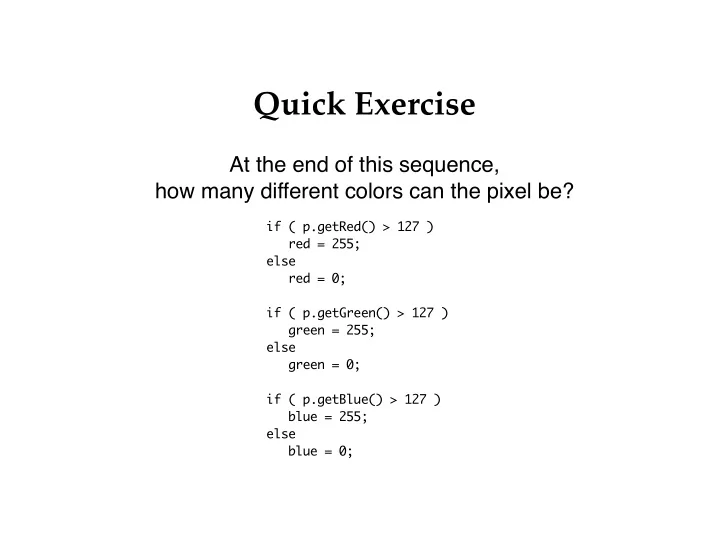

Quick Exercise At the end of this sequence, how many different colors can the pixel be? if ( p.getRed() > 127 ) red = 255; else red = 0; if ( p.getGreen() > 127 ) green = 255; else green = 0; if ( p.getBlue() > 127 ) blue = 255; else blue = 0;
Alternative 1 How about this one? if ( p.getRed() > 127 || p.getGreen() > 127 || p.getBlue() > 127 ) { red = 255; green = 255; blue = 255; } else { red = 0; green = 0; blue = 0; } ... what if we change the || to && ?
Alternative 2 How about this one? if ( p.getAverage() > 127 ) { red = 255; green = 255; blue = 255; } else { red = 0; green = 0; blue = 0; }
One Short Cut A type in the problem left you with a hint... int red = 0; int green = 0; int blue = 0; if ( p.getRed() > 127 ) red = 255; if ( p.getGreen() > 127 ) green = 255; if ( p.getBlue() > 127 ) blue = 255;
A Programming Pattern When you make a design decision: red + green < blue is a good way to determine if a pixel is blue ... write a method to encode the decision: public void isBlue( Pixel p )
The Physics of Sound amplitude <---- one cycle --->
The Psychology of Sound We perceive volume as change in amplitude . If amplitude doubles, that is change of about 3 decibels (dB). We perceive pitch as change in frequency . We can hear between 5 Hz and 20000 Hz (20 kHz).
Logarithm Scale Human hearing works with ratios , not differences. For pitch, this means ... 200 -> 400 Hz ~ 500 -> 1000 Hz 300 -> 600 Hz ~ 1500 -> 3000 Hz
Volume on Log Scale A decibels is based on the ratio between two volumes: 10 * log( V1 / V2 ) The absolute measure is in comparison to the threshold of our hearing: 0 dB cannot be heard. 60 dB is normal speech 80 dB is considered shouting
Digitizing Sound We can estimate the area under a curve using a sampling of rectangles. To encode a sound, we record the amplitude at a point in time — the height of an implicit rectangle.
How Many Samples? Nyquist's Theorem To represent sounds with a maximum frequency of n , we need 2n samples. Human voices max out at ~ 4 KHz. So phones work with 8000 samples per second. Human hearing maxes out at ~ 22 KHz. So most digital audio works with 44,000 samples/second.
Encoding a Sample of Sound Each sample = 2 bytes, or 16 bits. ^ <------------ the rest stores the value ------------> used to indicate sign 2^16 = 65,536 -2^8 = -32,768 2^8-1 = 32,767
Encoding a Sound Each sound is an array of samples. <------------ one slot for each sample ------------> 44,100 samples = 1 second of sound
Working with Sound new Sound( ... ) getSamples() getLength() getSamplingRate() getSampleValueAt( int slot ) setSampleValueAt( int slot, int newValue )
Recommend
More recommend